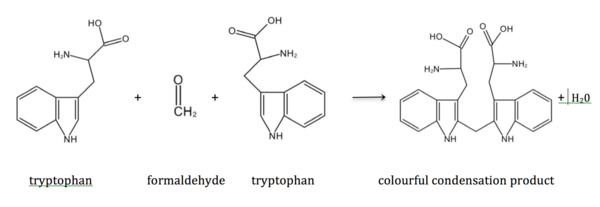Biology:Acree–Rosenheim reaction
The Acree-Rosenheim reaction is a chemical test used for detecting the presence of tryptophan in proteins. A protein mixture is mixed with formaldehyde. Concentrated sulfuric acid is added to form two layers. A purple ring appears between the two layers if the test is positive for tryptophan.[1][2][3] The test was named after two greats in biochemistry, namely, Solomon Farley Acree (1875–1957), a distinguished American Biochemist at Johns Hopkins University, and Sigmund Otto Rosenheim (1871–1955), an Anglo-German Medical Chemist at the University of Manchester.
History
The method was originally investigated by Otto Rosenheim while examining and improving on the methods by German British chemist Otto Hehner (1853–1924) that was used to detect formaldehyde in milk by adding sulphuric acid, which produced a blue ring. Acree noticed the reaction's similarities with the Adamkiewicz reaction and the reaction noticeably higher in casein.[4] Based on this 1906 research, Acree investigated the reaction in 1907 in the general context of formaldehyde reactions with all forms of protein and was the first to find the importance of the tryptophan group in the reaction, which can be extracted from casein in milk.[5]
Reaction
The reaction of tryptophan with formaldehyde.
References
- ↑ Debajyoti Das (1980). Biochemistry. Academic Publishers. p. 56. ISBN 978-93-80599-17-5. https://books.google.com/books?id=QqXpWJHICUYC&pg=PA56.
- ↑ Louis Rosenfeld (2 December 2012). Origins of Clinical Chemistry: The Evolution of Protein Analysis. Elsevier. p. 76. ISBN 978-0-323-15292-1. https://books.google.com/books?id=yUYq53WulGIC&pg=PA76.
- ↑ B. Jain Publishers Staff (1 January 1999). Pocket Medical Dictionary. B. Jain Publishers. p. 16. ISBN 978-81-7021-193-8. https://books.google.com/books?id=hrOadz4G8RQC&pg=PA16.
- ↑ A COLOUR REACTION OF FORMALDEHYDE WITH PROTEIDS AND ITS RELATION TO THE ADAMKIEWICZ REACTION,published in biochemistry journal,1906
- ↑ THE CHEMISTRY OF HEHNERS TEST FOR FORMALDEHYDE IN MILK,1907
 |


